2021 Survey Data: Key Selling Challenges
Guest Author
Contents
At Richardson Sales Performance we asked sales professionals and managers about their most pressing selling challenges in 2021. The responses, totaling more than 700, provided a panorama of the selling industry and the ways it is changing.
Many sales professionals saw their pipelines diminish in 2020 as a direct result of the global pandemic. Therefore, “finding new business to fill my pipeline” was a key goal for selling organizations in 2021 and the most cited challenge across respondents. Meanwhile, sales professionals in industries that grew in 2020 now face the challenge of meeting higher selling targets this year.
While many are adapting to this new set of circumstances, “selling in a virtual environment” remains the second most common challenge among our survey population. These findings suggest that existing processes and methodologies need to be updated or supplemented with virtual selling adaptations, skills, and techniques.
In the following post, we look closer at these and other challenges revealed in our research. We seek to understand the “why” behind the challenges, and we offer the insights sales professionals need to overcome each one. Our recommendations come from our 40 years of experience.
2021 Selling Challenges
- Accessing the Right Stakeholders
- Engaging With Customers in a Virtual Environment
- Protecting Price and Maintaining Profitability
- Defending Against Competitors
- Dealing With Uncertainty Brought on by the Pandemic
- More Difficult to Connect Personally
Accessing the Right Stakeholders in a Virtual Setting Remains a Selling Challenge
When we asked our respondents to cite the primary challenges associated with finding new business to fill their pipeline, the majority (22%) indicated that prospecting in a virtual setting was the most significant hurdle.
Breaking through to the customer across digital channels during the distractions of a pandemic was a major challenge. Sales professionals often failed to connect with prospects and, as a result, struggled to “gain access to the right stakeholder,” which was the second most cited response to this question.
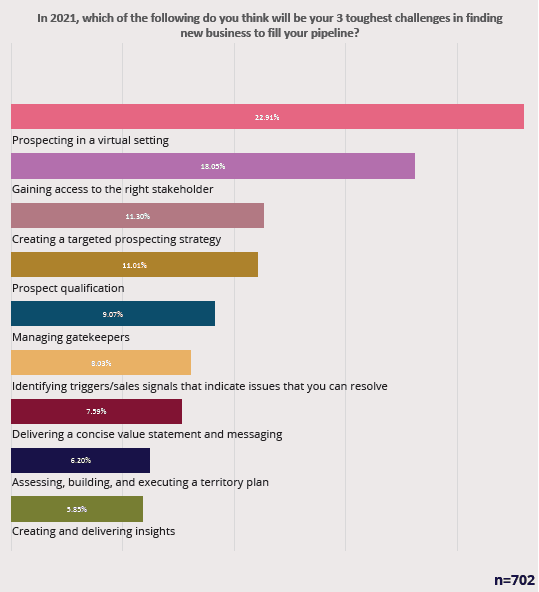
The net effect of these challenges is that sales professionals must find a new way to access the right people while using the right messaging. The most effective sales professionals are responding to this challenge in three ways:
1. Revise the Value Statement to Address New Challenges
Sales professionals must rework their value statement so that the messaging is relevant to the new environment by demonstrating their understanding of what is important to the customer, the ease of doing business together, and the specific outcomes the solution will deliver.
2. Build Incremental Value Creation
Without the availability of traditional prospecting channels, sales professionals must prepare for a longer path. Some call this approach “breadcrumbing” value. The idea is to rely on the incremental gains that come from repeatedly and reliably offering value to potential customers.
3. Deliver Messaging with Pinpoint Focus
The virtual medium offers some unique benefits that sales professionals can use to gain the appointment. For example, they can record a personalized video for prospects with a strong message to grab their attention or share a video that might speak to their current needs. The idea is to rely on the incremental gains that come from repeatedly and reliably offering value to potential customers.
Winning Active Opportunities Means Engaging Customers and Building Consensus from a Distance
The selling challenges associated with working in a virtual environment loom large even among active pursuits.
Nearly 19% of our respondents cited “engaging with customers in a virtual environment” as one of their top three challenges when pursuing in-play opportunities. The second and third most common challenges were “accessing decision-makers” and “driving consensus among various stakeholders,” respectively.
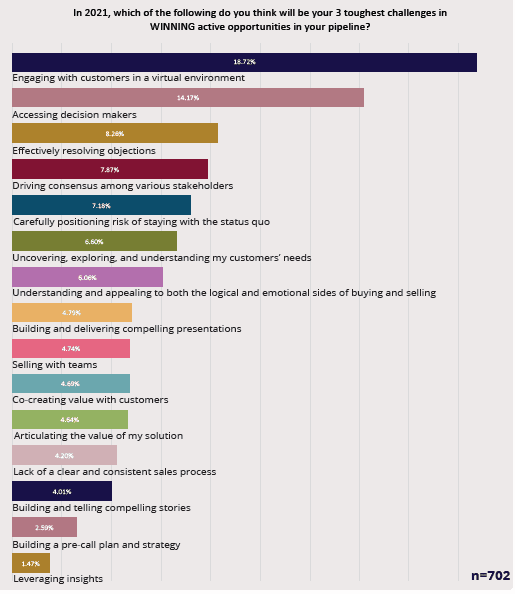
The increased work of building consensus and engaging customers is not just the result of adjusting to a virtual medium but is also tied directly to the pandemic. COVID-19 has forced many customers to redefine their business model. Redesigning the sales conversation to address these challenges means focusing on the following:
1. Understand the ROI Factors That Resonate with the Customer
The group of stakeholders will consist of decision-makers who each have a unique opinion about what constitutes value in the ROI. Stakeholders like the CFO are likely to be attuned to the financial benefits of a solution. In contrast, the stakeholders that are responsible for implementation might choose to focus less on the hard factors underpinning the ROI and instead examine the ease with which the solution can be integrated into business operations.
2. Become the Coach of the Buying Process
The sales professional can adopt the role of a coach by helping the buyer understand the scale of the buying process. Doing so means developing the customer’s comfort with each stage of the sale by building in checkpoints throughout the process.
3. Keep the Communication Candid
Open communication is necessary because positioning a solution requires understanding the customer’s pain points, and revealing such details is humbling. The sales professional must remember the concept of psychological safety, which is the ability to fluidly exchange ideas without fear of embarrassment.
Successful Negotiations Are About Preserving the Scope of the Sale
When asked about selling challenges in negotiations, nearly one-quarter of our respondents cited “protecting price and maintaining profitability,” making it the single most common difficulty among our participants.
Preserving the financial value of the sale has long been a challenge. However, today that challenge has intensified as customers look for ways to minimize spending while recovering from the economic fallout of the global pandemic.
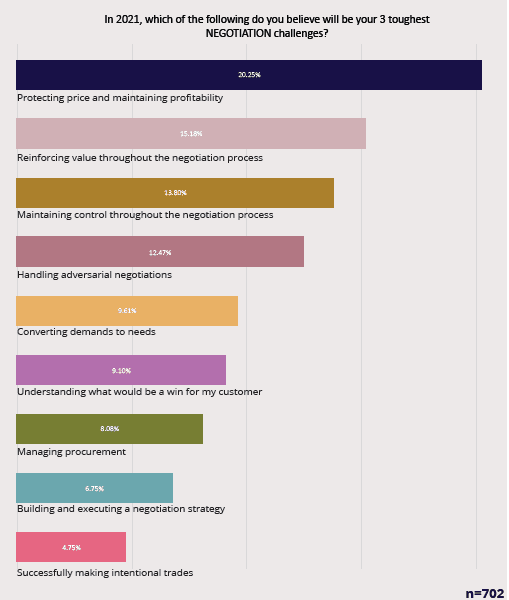
Sales professionals can prevail if they enter negotiations with an awareness of these threats. Fortunately, our research shows that some are already developing this awareness.
The second most cited negotiation challenge at nearly 15% is “reinforcing value throughout the negotiation process,” followed by “maintaining control throughout the negotiation process.” These high-ranking challenges indicate that sales professionals are developing an understanding of what they need to do to protect pricing. What remains elusive for many is how to do it. The answer to this question means committing to three practices:
1. Anchor Value When Making the Offer
Making the first offer demonstrates honesty. It shows the customer that the sales professional is not holding anything back or guarding information. This candor is crucial in negotiations because nothing can advance without the customer’s trust.
2. Convert Demands to Needs
In some cases, the sales professional may suggest a reduced solution to meet the customer’s demand for a lower price. That is, many negotiators move to trading too soon without a full sense of customer demands, needs, and priorities. The solution: investigate the customer’s demands. This approach is important because needs (e.g., “I need more flexibility in the payment schedule.”) are much easier to discuss and resolve than demands (e.g., “I can’t pay that much.”).
3. Shape Perceptions of Value
Sales professionals shape perceptions of value when they focus the customer on what they will gain by reaching an agreement and what they will lose by falling short. Creating this influence is important because it makes the customer more receptive to a trade later. Shaping perceptions of value does not require aggression. In fact, silence is one of the most effective ways to steer the conversation.
Managing and Expanding Accounts Means Defending Against Competitors
Dramatic cost-cutting, coupled with the burden of having to pivot or completely change a business model, has forced competing sales organizations to get aggressive in their approaches to the market. Therefore, it is no surprise that the most frequently identified challenge — at 19% — in managing and expanding existing accounts is “defending against competitors.”
The next two most cited selling challenges, both at approximately 16%, are “finding ways to add relevant value” and “expanding access and footprint into current customers.” These two related challenges likely stem from the fact that many existing accounts are fundamentally different than they were just months ago.
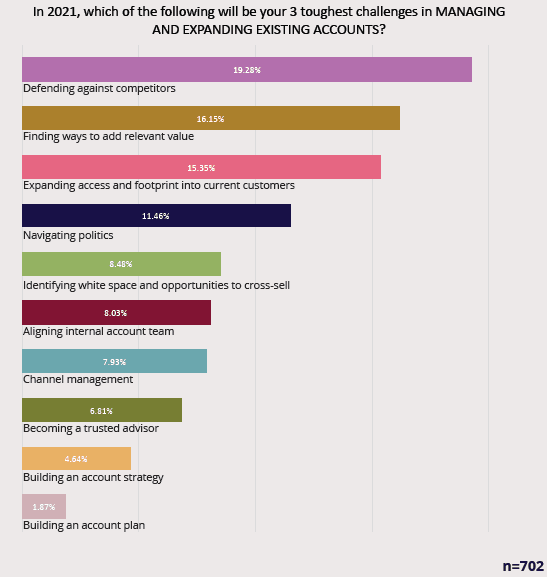
Adjusting the account management process to these new circumstances means adopting three practices:
1. Revise the Value Positioning and Address Risks
Many sales professionals find it necessary to conduct a new value justification analysis for key accounts. Here, it can be helpful to share financial projections with customers that clearly define expected outcomes. This same data can be used to articulate the opportunity cost associated with inaction, a cost that only compounds over the long term.
2. Clarify the Account Plan Methodology
Sales teams need to consistently work from a clearly defined account plan methodology. This process means analyzing each strategic account and restarting the process of identifying and ranking each account’s greatest pains. This approach is critical because the major pain points have changed for nearly all customers.
3. Create a “Proactive” Response Team
Some of the most effective sales teams are preserving revenue by creating a response team. These teams define policies and anticipate accounts’ requests and standardize the response. However, the response team is not simply there to respond — their purpose is to also be proactive by formulating responses in advance of inevitable calls to narrow the scope of the sale, provide additional discounts, or even end the business relationship.
Pandemic Uncertainty Looms Large Among Buyers Making Decisions
Across all questions, our respondents were never more united than when they were asked about the biggest challenge buyers face when making a purchasing decision.
Overwhelmingly, sales professionals and sales leaders believe that “dealing with uncertainty brought on by the pandemic” is the single greatest challenge stakeholders face when considering a purchase. Just over 41% of our participants cited this as the buyer’s largest burden. At 16%, the second most cited challenge sales professionals believe buyers face is “managing constantly shifting priorities.”
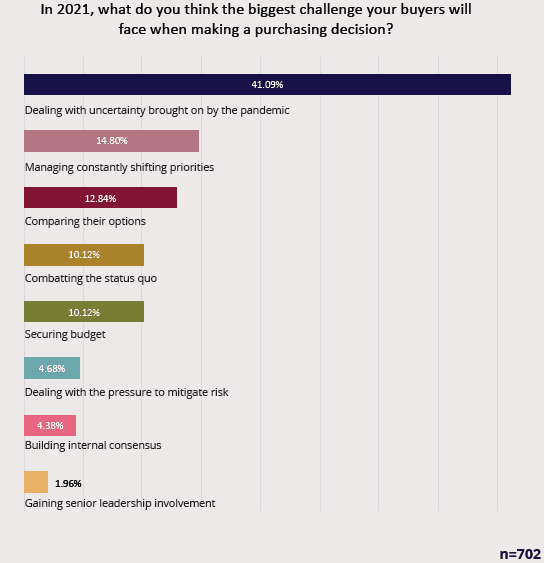
These top two selling challenges are connected because heightened uncertainty often leads to inconsistent priorities. Simply, as the road becomes more winding, the wheel must turn more dramatically. Helping customers in this setting means doing three things:
1. Understand How Short-term Emotions Drive Long-term Decisions
The buying process is an emotional experience. Reputations and finances are at stake. Many sales professionals understand that these emotions influence the customer’s buying decisions. Addressing the customer’s emotions means first illustrating the real-world outcomes the solution has brought to similar customers.
2. Become a Better Listener
A great listener possesses one of the strongest competitive advantages without having to spare anything but a bit of time and attentiveness. Good listeners regularly make an effort to do three things well. First, they encourage the speaker to provide more detail. Second, they engage in mirroring by mimicking the speech, cadence, gestures, and even attitude of the person speaking. Third, they use questions to confirm the speaker’s key points.
3. Investigate the Customer’s Decision Process
The more the sales professional knows about how the decision process works, the better prepared they are to be alert to discrepancies and cues revealing who the influencers are in the process. With this information, the sales professional is equipped to redirect the process when necessary.
Developing Personal Connections Virtually Presents Difficulties
Since the earliest months of the pandemic, most people have made great strides in adapting to the virtual medium. Despite this, challenges remain.
Overwhelmingly, our respondents indicated that the predominant challenge of selling virtually is that it is “more difficult to connect personally.” Physical distance prevents sales professionals from gaining a close reading of customer emotions that come from physical cues that are difficult to perceive on-screen.
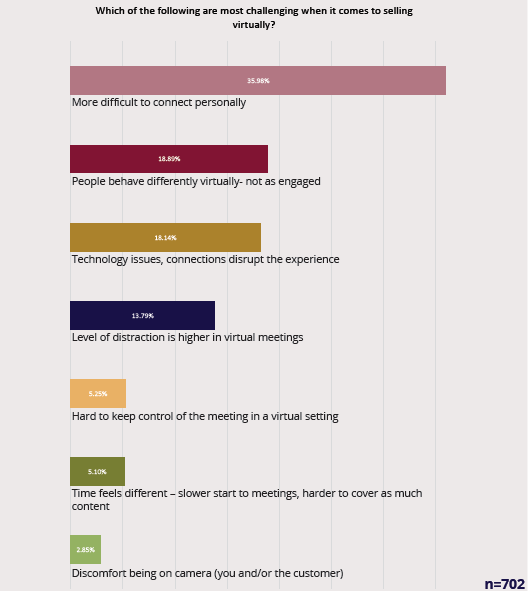
Moreover, there seems to be a norm developing in which distractions are more acceptable when conversations are virtual. The good news is that flexible sales professionals can adjust to this new setting by making a few changes:
1. Develop an Approach Around Authenticity and Transparency
Customers are subject to an array of influences including the emergence of digitally oriented and self-directed buying options, and uncertainty stemming from the pandemic recovery timeline. With less certainty comes a greater need for transparency and trust from the sales professional. They must bring credibility to their solutions by displaying authenticity in both words and actions.
2. Make Trust Building a Priority
Building trust means understanding the role each decision-maker inhabits so that they are better equipped to speak to individualized concerns. Sales professionals should also ensure that they engage all of the decision-makers by directing questions to specific individuals during virtual meetings. Finally, sales professionals should foster an atmosphere of shared success.
3. Develop Communication That Earns the Customer’s
Effective virtual selling skills are a precursor to trust. Trust is a precursor to making the sale. Therefore, strong communication skills should be the primary focus of any sales professional working in a virtual setting. Sales professionals must avoid defaulting to presentation mode rather than conversation mode, especially if they are sharing slides.
Summary
- Gaining access to stakeholders means developing a sharper value statement, building value gradually, and creating targeted messaging.
- Overcoming the limitations of a virtual setting means addressing relevant ROI needs in candid conversations guided by the sales professional.
- Sales professionals need to prepare for aggressive negotiations by anchoring the value of the solution and following a trading strategy.
- The competition is intense enough to threaten even existing accounts; therefore, sales professionals must revise account plans around a more flexible approach.
- Addressing the customer today also means understanding their emotions by engaging in active listening that explores the factors guiding their decision-making process.
- Forming connections across the virtual medium requires a new approach that works with the parameters of the medium rather than around them.
Author: Ben Taylor from Richardson Sales Performance
Want to write for our blog? Apply here: Yesware’s Spotlight Contributor Application.
Get sales tips and strategies delivered straight to your inbox.
Yesware will help you generate more sales right from your inbox. Try our Outlook add-on or Gmail Chrome extension for free, forever!
Related Articles
Jenny Keohane
Jenny Keohane
Jenny Keohane
Sales, deal management, and communication tips for your inbox

